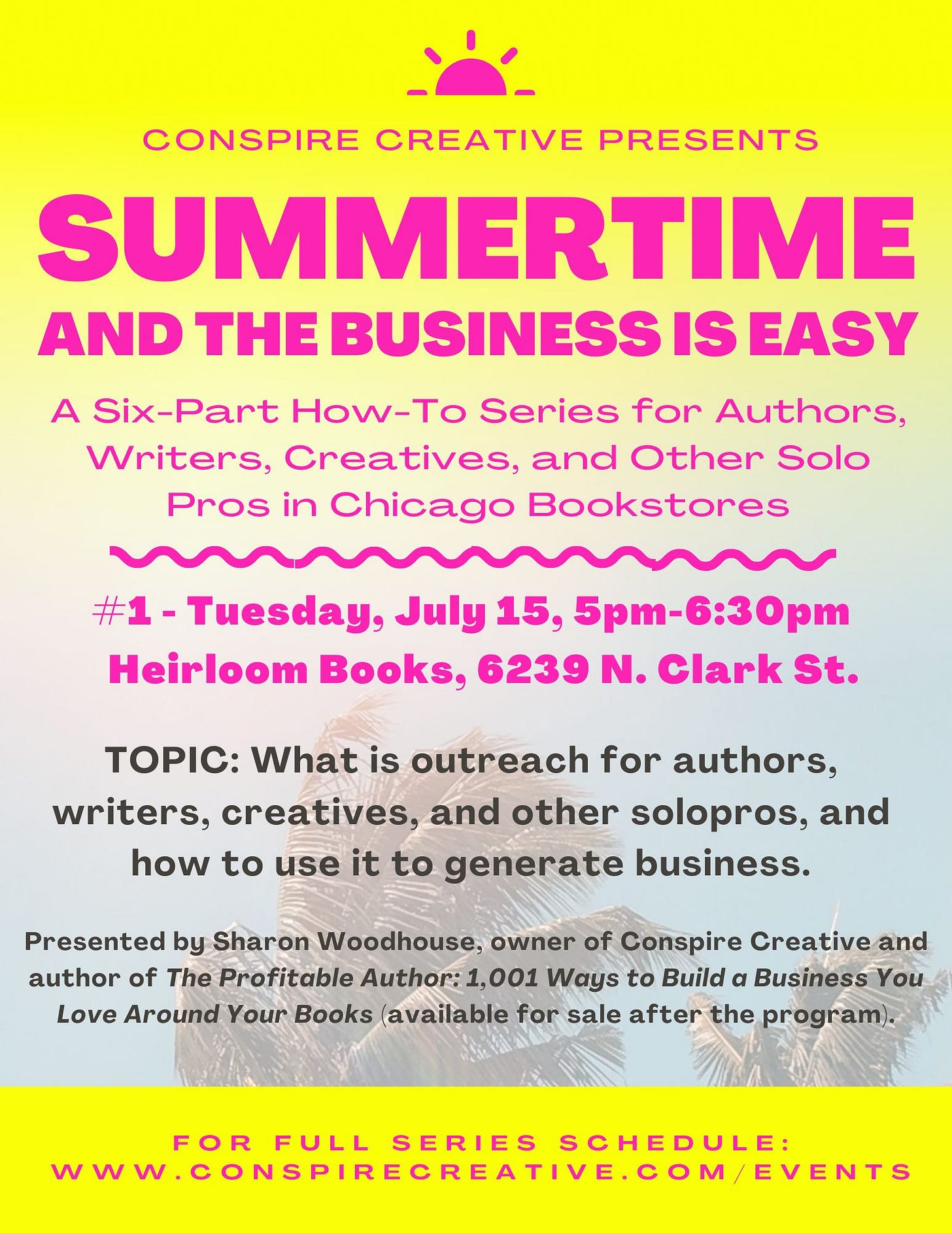Authors, Here's a Ready-Made Income Stream: The One-Hour Consult
Adopt my template and share what you know on a topic in an easy and profitable way

There’s a service I’ve delivered hundreds of times in the last 20+ years that is so fun and easy for me — and so beneficial for clients — I wish I had more takers for it. And, if you happen to have a degree of knowledge or expertise in a certain area, you can borrow my simple model for offering your own version.
I call this one-hour conversation people pay me for: One Hour with a Publisher. Aimed at aspiring and established authors, it invites customers to ask me any and all questions about book publishing and bring me their most exasperating industry problems. I’ve met other professionals who offer something similar for QuickBooks questions, LinkedIn advice, and Disney World vacation planning. Let me walk you through the structure so you can see if the idea is adaptable for your circumstances.
Value Proposition
What’s the value proposition? That your client gets all of their particular questions answered for their purposes, your insights as an expert on their specific situation, in a one-hour call — almost on demand, depending on your schedule.
In my case, I offer authors a seasoned publisher’s answers to all their questions on book publishing, book marketing, publishing options, the finances of publishing, etc. in one hour’s time. Some of it is handing over factual information, but more important is that it’s passing on the perspectives, opinions, context, and experience that the person specifically wants for their unique situation, including what they don’t know they need to know.
The Big Challenge
The biggest challenge to the one-hour call service is that it is mostly a one-and-done situation. Each call is complete unto itself, meaning that in order for this to be a meaningful income stream, you need a way to attract a steady stream of one-time clients, which you may or may not easily be able to do.
There are some ways to mitigate this challenge and/or work around it:
Promote your service everywhere. Include it in your email signature and social media bios. Make it prominent on your website and business cards. Mention it front and center when discussing your work.
Automate the process as much as possible (see the next section).
Have other compatible services to offer to extend the relationship. Only mention these when the conversation is otherwise done or in a follow-up email so as not to take up their time for asking questions on your promotion. For example, my company and I also provide author coaching and consulting; review agent and publisher query letters; evaluate book proposal packages and manuscripts; take on the occasional editing project; and do start-to-finish project management of legacy and self-publishing book projects.
Ask for referrals at the end of every call and in your brief follow-up email.
Structure of the Ad and the Sign-Up
Much of the success of these calls rests, in my experience, on just how little time one hour seems but how much time it actually is for conveying loads of information. When you know things your client doesn’t, you can pack real value into every minute. Convey this in a simple ad.
Right up front in my marketing copy, I tell people that one hour is usually enough time to get all their questions answered. Then, I list the most likely things they can also get from the same call. These are the things that I, as the expert, have determined are the biggest source of value and that I know from experience those on the other end of the call respond to most. Then I ask them to sign up now. Don’t delay getting just the right advice for getting your project off to a strong start. Implied: Think of all the time and money you’ll save by knowing just what to do and avoiding mistakes.
Use my list to figure out which 5–7 significant things you can suggest to those who sign up to learn from you for one hour.
Hear a publisher’s opinion on different courses of action
Learn the strengths and weaknesses of your book or book proposal
Discover workarounds for the obstacles you and/or your project face
Discuss nitty-gritty financial details of traditional vs. self-publishing
Receive marketing advice customized for you and your book
Strategize with an expert on the best publishing path forward for you and your book
My promo text is all viewable on one screen with no scrolling. A calendar at the end allows people to book time with me and pay through PayPal, which can’t make it much easier for the average person to set up and automate sign-up and payment collection for various services.
When I receive a notice in my email box that someone has signed up, I:
send a brief thank you email confirming the appointment,
tell them I will call at the chosen time on the dot and they can begin questioning me immediately, and
let them know to have lots of questions prepared because we’ll be able to cover a lot of territory.
Now, when someone asks if they can take you to coffee to pick your brain, you can instead direct them to your one-hour call service and your sign-up calendar.
Structure of the Pricing
I charge $200 for the call, which allows for the roughly 20 minutes total of pre- and post-call contact and accounting and PayPal fee. You should charge what your clients are willing and able to pay you. If your one-hour meetings would work better in an office setting or even a walking meeting, adjust your prices upwards to account for the extra prep time and the inconvenience factor.
Structure of the Call
Call your customer on the dot. Do not allow any opening for the client to feel they’re not getting their time or money’s worth.
Keep your initial pleasantries to a bare minimum, again so that the recipient will get, and have the perception of such, as much value as possible from the call. Use a warm, smiling, open, friendly tone to convey this bare minimum and set the right tone, then get down to business.
The client will be looking to you for direction, so give it to them. Facilitating the call is part of your job so tell them at every stage what’s going on or what they should do. My opening line is something like, “Hi so-and-so, thanks for signing up for a one-hour call, let’s not waste a minute. Tell me about you, your book project, why you’re calling, and feel free to start firing away with your questions.”
My art of answering questions goes something like this: provide the direct, factual information first; then give context and variations; then give real-life examples; then connect any needed dots of relevance to them and their project. If they don’t automatically move on to their next question, ask what their next question is.
Each time you speak you should be sharing real expertise; delivering value applicable to their situation; and establishing and maintaining your credibility. The purpose of this last item may not be obvious, but it’s important. The weight of your credentials will help the client enact your good advice when the call is over.
It is often the case that the client runs out of prepared questions and new questions that rise up naturally in the course of your conversation. There are three different ways I keep the conversation going in such cases: 1) ask them questions about their project that have come up for me that may be handy for them to think about/discuss further; 2) ask them if they have questions in specific categories that I think are germane but they haven’t delved into (for me, this is usually something like, “do you have any questions about agents, marketing, or book budgets?”); and 3) propose what I think are the next most useful areas for them to know about (for instance, I often suggest something like, “Would you like a breakdown of what it actually costs to self-publish a book like the one you’re thinking of?” or “Would you like some ideas about how an introvert promotes a book successfully?”).
About ten minutes before the call is set to end, ask your customer if there are any last questions they have. Then move on to asking how the call was beneficial to them. Don’t ask if — you’ve been giving them your best advice all along— ask how to learn about their perceptions and what they think they’re walking away with.
After appreciating and acknowledging their responses, there are three primary things for you to communicate: 1) what you think the most salient points of your conversation were; it’s time to recap your expert insights; 2) reminding them to implement what they’ve learned and suggesting a mini order to that approach (“I suggest first doing a, then b, and when you’ve done c, you can x, y, z.”); and 3) thanking them again for calling and asking them to refer you to others you know who may benefit from such a call.
End on time, hitting that exact 60-minute mark if possible. It conveys polish, professionalism, and customer service.
Structure of the Follow-Up
Always follow-up with your client by email either within a few minutes of the call or the next day. There are pros and cons to each, so pick what makes the most sense to you and the situation.
Keep it short. They have already received the service they paid for.
Share any promised resources such as an article, the name of a book, a link, or a contact.
If there was nothing promised, have some stock options for helpful resources you can suggest.
Let them know about any relevant services you have that may also be useful for them.
Thank them one more time and remind them to suggest you to others they know who have their own questions on your topic.
One-hour conversations in which you answer questions, provide perspective, and deliver clients customized information on your area of expertise is a fun and easy service to add to your author business, and a terrific value for customers to get just the advice they need quickly. Use or tweak my basic template for success sharing knowledge of your specialty.
Do you already offer such conversations? Let us know your area of expertise in the reply section.
Sneak peek at my Summertime and the Business Is Easy series. I’ll be talking about my top six topics in six different venues in six different neighborhoods around Chicago—and selling my new book and promoting my services afterwards. Here’s number 1
.




